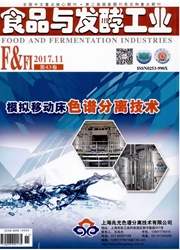

 中文摘要:
中文摘要:
以葡萄糖浓度和葡萄糖得率为指标,探讨了麦芽糊精浓度对其糖化的影响,并对机理进行了分析。结果表明,随着麦芽糊精浓度的提高,糖化得到的葡萄糖浓度及其得率都呈现先上升后下降的趋势。麦芽糊精浓度为50%时,糖化液中葡萄糖浓度最大,糖化48h时达到531.3mg/mL;浓度为20%~40%时,葡萄糖得率较高,糖化48h时达到90%以上,浓度为50%时,反应前期葡萄糖得率较低,但反应48h时仍能达到88.7%,当浓度为60%时,葡萄糖得率明显下降,反应48h时葡萄糖得率仅为69.3%。其主要原因可能是:麦芽糊精溶液浓度较低时,随着浓度的升高,反应体系中麦芽糊精的分子密度交大,酶和底物碰撞概率增加,糖化得到的葡萄糖浓度以及葡萄糖得率呈现上升趋势;但随着浓度继续升高,特别是浓度超过50%时,体系黏度明显增加,体系的水分活度降低,水分流动性变差,自由水分减少,抑制了糖化反应,导致葡萄糖浓度和葡萄糖得率均呈现下降趋势。
 英文摘要:
英文摘要:
The effects of mahodextrin concentration on the saccharification were investigated by using glucose concentration and yield as the indexes, and the related mechanism was analyzed. The results showed that the glucose concentration and yield of saccharification reaction both increased first and then decreased with the rising maltodextrin concentration. The glucose concentration in the saccharification solution reached the peak (531.3 mg/mL) after reacting for 48 h while the initial maltodextrin concentration was 50%. The glucose yield was higher at 20% -40% maltodextrin concentration, reaching 90% after saccharification for 48 h. The glucose yield was lower at 50% maltodextrin concentration at the early stage of the reaction, however it reached 88.7% after saccharification for 48h and decreased significantly to 69.3% while the initial mahodextrin concentration reached 60%. The main reasons might be that the molecular density of the mahodextrin increased with the rising concentration in the low concentration solution of maltodextrin. Thus, the probability of collision of enzyme and substrate increased with the rising concentration, which resulted in the increase of glucose concentration and yield. However, as the further rising of the maltodextrin concentration, especially exceeded 50% , the viscosity of the system increased obviously, the water activity of the system reduced, the mobility of water became poor and the free water became less, which might inhibited the saccharification and resulted in decreasing glucose concentration and yield.
 同期刊论文项目
同期刊论文项目
 同项目期刊论文
同项目期刊论文
 期刊信息
期刊信息
